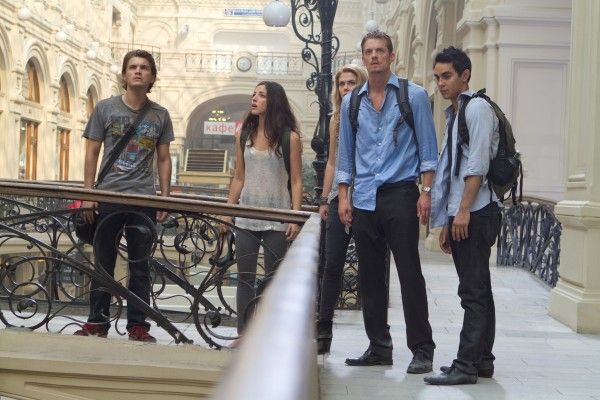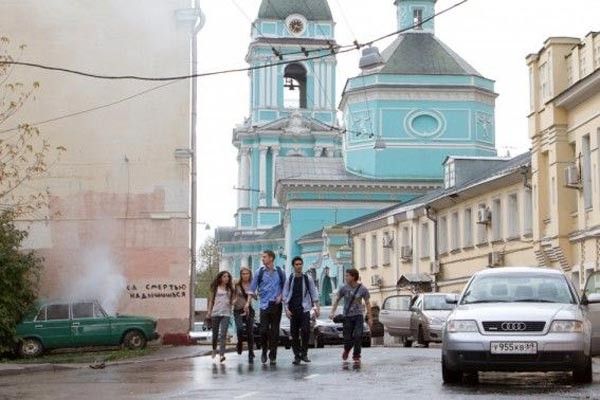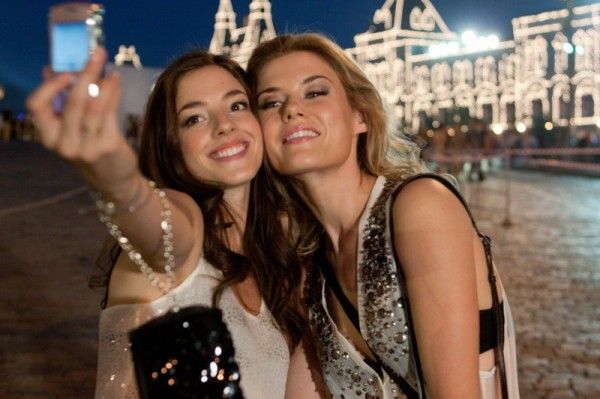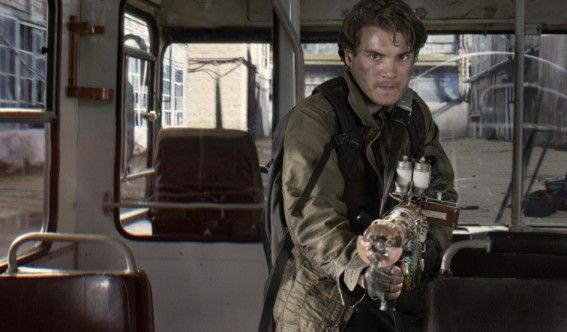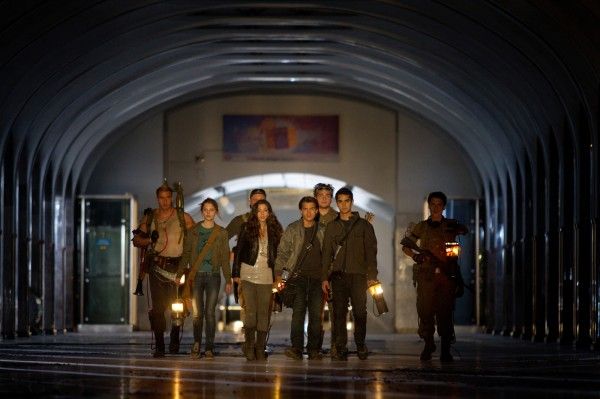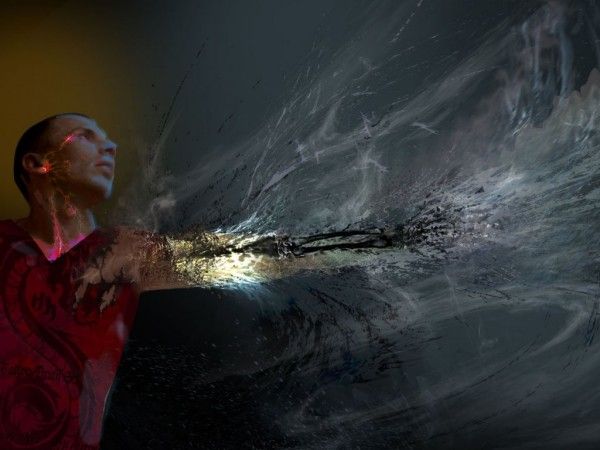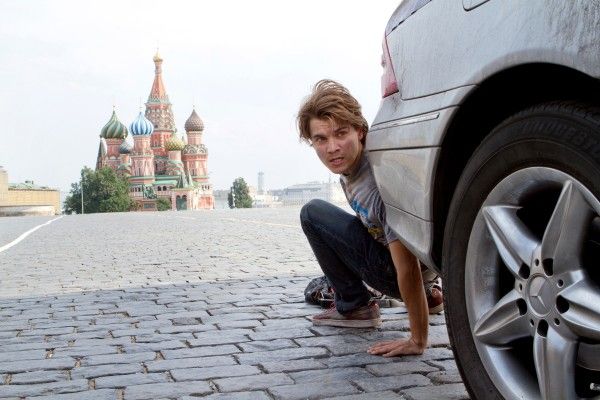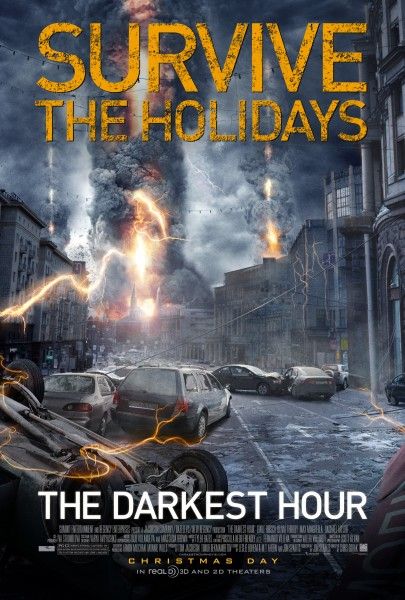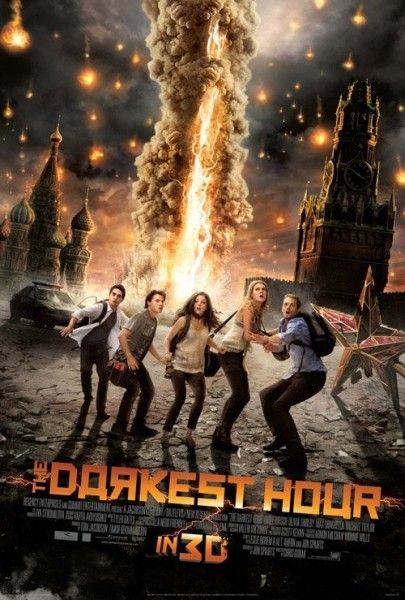In September of 2010, straight from the Toronto International Film Festival, I got to do something very cool: I went to Moscow and visited the set of Summit Entertainment’s alien invasion movie, The Darkest Hour. Normally when I say I got to visit the set, it involves going to a huge soundstage and sitting around conducting interviews. However, The Darkest Hour was a bit different: the production was filming in 3D on the streets of the city and in and around some of the most famous landmarks on the planet.  It was a set visit unlike any I’ve ever been on and it should make for some awesome visuals in the finished film. While I already posted the group interview I did with producers Timur Bekmambetov & Tom Jacobson and Emile Hirsch, it's time for the one with Joel Kinnaman. During the interview, Kinnaman talked about who he plays, filming in Moscow, working with the Russian crew and Bekmambetov, the 3D cameras, the rest of the cast, what it's like being in his first Hollywood movie, and his thoughts on getting ready to film AMC's The Killing (when we did this interview he had only done the pilot). Hit the jump for more.Before going any further, if you haven't seen the latest trailer, you should watch that first. The Darkest Hour gets released Christmas Day.And here's a few things to know from the interview:
- Kinnaman’s character was originally supposed to be a German businessman but after his casting, he was changed to a Swede.
- His character starts out as a villain.
- After seeing Avatar, he says he really wanted to be in a 3D movie.
- Things go slower when working in 3D, and the lighting is more demanding because things need to be brighter.
Question:Â Did you stay here during the break (when filming stopped due to the fires)?
Joel Kinnaman: No, I went back to Stockholm. I live both in Stockholm and LA.
It’s nice to have a little time off too.
Kinnaman: Yeah, I was actually going to go on a break anyway. I already had plans to go home.
Can you tell us a bit about who you play in the movie?
Kinnnman: Originally, he was supposed to be a German businessman, but after I met with Tom [Jacobson] and Monnie [Wills] when they were asking me my feelings of this character, I kind of went into a Dr. Strangelove mode, and was like, “Everybody wants to play a German,†so they changed it to a Swede. They thought that would be best. I play this businessman who is associated with Sean (Emile Hirsch) and Ben (Max Minghella) who rips them off and steals their idea. So they come here and end up empty-handed and then, unfortunately for them, I team up with them when everything goes down. So we’re all trying to survive together.
So you’re a good guy or a bad guy?
Kinnaman: Well, in the script I guess he’s written pretty much as a villain in the beginning at least and I’ve tried to nuance that as much as I can. But that’s how he starts out, definitely as a bad guy.
So your character evolves then? Originally, you think he’s bad but he becomes more heroic later?
Kinnaman: A little bit like that. He definitely has a journey. I tried to make him like a strong, selfish, egotistical businessman at start, but I’m the one who panics most when the aliens come. So I go into a lot of panic.
What is it like shooting in Moscow? Is it interesting or odd?
Kinnaman: Very interesting. In the beginning, there were a lot of challenges with the weather; it was incredibly hot. At that point, the heat in Moscow wasn’t hospitable; no city is when it’s that warm. But I had a great experience, met a lot of great people, made a lot of friends here. It’s an exotic place. For me, growing up in Sweden, the Russian mentality isn’t that different from people in the north, in Sweden, are. They are also quiet and reserved and don’t give away that much. You have to get to know somebody, but at the same time you can always trust the sincerity in a sense. I think it’s the absolute opposite from the character of Hollywood, where everybody is smiling and saying that they love you after two seconds. For me, it wasn’t that big of a transition. I felt kind of accustomed to the Russian mentality.
Does that reflect in the film? Is it quite different with the Russian crew and Timur [Bekmambetov] involved?
Kinnaman: I think so, I think so. Everybody here from the U.S and from that part of the crew that’s not from Moscow, we’re all on foreign ground so it kind of forces everybody to come together. Nobody is going home to their friends after work. You know, there are a lot of challenges, like shooting with a lot of communication and weather. All this made us tighter as a group. So it’s been very good.
Is this a project that you went after or did it come after you? Could you talk about that?
Kinnaman: It came after me, I guess. Well, I got a call that they wanted to meet me, I read the script, and I thought it was really interesting. After I saw Avatar, I had this little dream: I wanted to be in a 3D movie. I’m very excited about that new technique, so it was an opportunity to be in a very interesting story in a 3D world.
Could you talk a little about working in 3D and the 3D cameras? How does that affect you as an actor, because I know it goes a little bit slower working in 3D?
Kinnaman: It goes a little slower because they have to plan the picture a little bit more thorough. There are some things that don’t play as well in 3D, especially when you’re moving around, like when the picture gets dirty and somebody’s shoulder is in it, that doesn’t play very well in 3D because it’s just something in the frame of the picture that will just pull out. I think they try to keep the images clean and more well-planned. And then the lighting is more demanding in 3D, so it needs more light. So, it takes a little bit of a longer time, so the pacing is a little bit slower, but apart from that, as an actor, it doesn’t matter that much.
We have been shooting a lot of big images. I came to understand that after about a week of shooting that they were really using master shots a lot; they want these big epic shots. For me, I’ve played a lot of theater, it became interesting because they got a lot of opportunities to expand in that way. You can move around a lot and use the scenery. It’s a little bit like theater in that sense. We had some scenes, too, that have been improvised.  It’s just like one big shot in a room and we just get to improvise. Surprisingly, doing this kind of a movie, which is a summer popcorn kind of movie, but I’ve been surprised that we’ve actually had the chance to get into some really interesting acting in it. It’s been fun.
It’s quite an eclectic, international young cast, how has that chemistry been working?
Kinnaman: Very good. We’re like a tight group. We’ve really come together, we hang out every day, and we’re having a good time. Everybody’s really different but we all really like each other. We have a lot of fun. Also, having a lead like Emile [Hirsch], who’s a mature non-insecure kind of actor that doesn’t have to suck up all the energy in the room to feel important has also been very helpful for the group dynamic. Everybody’s giving each other room and being very positive and supportive of each other so it’s been a really good, mature experience.
Do you remember the specific moment from the set when you really noticed a cultural difference?
Kinnaman: Yeah, but I wouldn’t want to hurt anybody’s feelings. I’ll have to think of something else. Um…not really. No, I can’t say that any…there’s been a lot of communication misunderstandings, but nothing serious and nothing that we haven’t been able to come around. The Russian team, I guess, is not really used to this kind of big production, but they’re all really professional in their way of working. Yeah, so we just had to get over those first culture barriers where you realize that just because someone’s not smiling at you, it doesn’t mean that they not liking you.
How have you found acting opposite stuff you can’t see, the aliens, etc? How have you found that experience?
Kinnaman: I’ve done it before, a little bit. I did like the biggest Swedish film ever made, which is about probably half the size of this movie, where there was that technical element where you have to envision stuff that’s not there. That comes into a lot of movie acting. Sometimes they want your eyeline to be so close to the lens so you hear the actor’s voice but you can’t look at them. You have to look at a little mark close to the lens. There’s always that…it’s technical acting, but at the same time it plays into your ability to fantasize and live yourself into the situation and the fantasy that you’re trying to create.
Have you’ve grown up with science fiction at all?
Kinnaman: Hell yeah. Star Wars was my first big movie experience when I was a kid. I got to watch Star Wars on my parents’ 14-inch TV and I’ll never forget that.
What’s it been like working with [director] Chris Gorak?
Kinnaman: Very good. He’s incredible, considering this is his second film and that his first was a very small independent movie, it’s just astounding the control he has over the set and over his vision and how open and also how un-insecure, or secure, he is with accepting your ideas and listening to your ideas and still he has his vision and structure that he wants it to be within, but you still really feel that you can add a lot. Then, of course, this is only his second film as a director. He’s also been an art director for very many big movies, including Spielberg films. He’s very used to a big set. He knows that dynamic and you definitely do not feel that he’s a rookie. I never thought that a second.
But were you afraid coming from the background of an art director that there was going to be a sacrifice made for performance taking a second place to design?
Kinnaman: I wasn’t. I mean, there’s always a fear when you start working with somebody that you don’t know from before. You don’t know how they are going to respond to you or to your ideas and how you’re going to feel in the situation. So, there’s always a sense of fear before you start working. I had a million different fears, but hardly any of them have come true. So it’s been a really good experience. I really felt well taken care of and also he’s let me be creative.
This is your first, I guess, big Hollywood film so how has that experience been? Has it differed much from what you’re used to?
Kinnaman: Except for just the size and the amount of people, yeah. It has. At the same time, I’ve done a lot of films in Sweden in a short time so I’ve been working a lot. So I felt kind of warm coming into this. If I hadn’t, I would have been more intimidated by it and felt more nervous about the situation. Of course, there’s always nerves and you’re scared in the beginning but no, it’s not that big of a transition.
Are you prepared to take the next step in your career, now with this opening doors in Hollywood, are you going to start focusing more on Hollywood films or are you going to split time between Sweden and L.A?
Kinnaman: I kind of made that decision even before I got this. And even before I got this, I did a pilot for an AMC series that while shooting this got picked up, so after that I’m going to go Vancouver and do an AMC series.
What’s that?
Kinnaman: The pilot is called The Killing. I think they are going to rename it for the series. It’s a remake of a Danish series called The Killing, which is a fantastic Danish series. It’s the most successful Danish series ever. I heard the crime dropped 15% when it was airing, it’s like 40% of the population was watching it. It’s also very popular in Sweden. So, I think I’ve already made that choice. I’ll probably go back. I did a Swedish film, that was a reason I got this, called Snabba Cash and they want to make that a trilogy. So we’ll see when we’re going to do that because Daniel [Espinosa], the director, he’s doing this movie Safe House for Universal, so he’s going to be tied up for a while. So, I’ll see. I might go home to do some work if it’s interesting. I’m still really young in my acting career and I really need to choose the interesting work that makes me evolve. I don’t really care where they’re at, but of course my focus is on the U.S and the international market after doing this.
A lot of actors like doing 2 or 3 takes, and they feel like they’ve given it in those 2 or 3 and some actors want to go like 30 times, as an actor are you more like “first take is my magic†or it doesn’t make a difference how many takes?
Kinnaman: I think I’m a 2nd and 3rd kind of guy, so that’s worked out pretty well here, because there hasn’t been that many takes. There’s been a lot or pressure, so we realized really quick that we had to be extremely well prepared and know what we want to do. Some of the scenes there was not that much time to play around, there was just…to give it that first image that you had of it. I rarely do my best work in the 5th or 6th, it’s like 2nd or 3rd, maybe 4th.
I definitely want to do a follow up on the AMC show. How was it for you, now that you know you’re doing movies, obviously AMC is an incredible network and all the stuff they’ve done so far has been just extraordinary…is it a concern of yours to sign onto something, most networks make you sign a 5 year contract, sometimes even a 7 year contract, how fearful were you to sign on, and is there a contract like that for you?
Kinnaman: Yeah, I have that kind of contract. It wasn’t a fear considering the quality of the show, especially after doing the pilot and hearing the reasoning and the decision making which was everything but I guess the European view that sometimes an American project can be shallow, you know, people more beautiful than real. This was everything but that. For me, I think for a lot of actors now, TV has become, for American actors, what theater is for European actors—it’s where you go and do your more deep-going character work. If this goes for 4 or 5 years, I’m going to be happy to do it. And also, it’s a limited period of the year; it’s about 5 months a year. Even though you do your series, then you have the opportunity to do at least one or maybe two more movies a year.
There are a lot of alien invasion movies in the works recently; this one seems a little bit different. I wanted to know what you think sets this apart from the other ones?
Kinnaman: I’m not that familiar with the other ones. I think there’s always an appetite for that, that fantasy of the aliens coming and the great unknown coming to us. But then also with everything that’s happening, the climate changing, I mean we’ve seen so many catastrophes this year, there’s a lot of stuff going around us that shows us how fragile our civilization is. It becomes a metaphor for that. We think that we’re so safe on and we’re on the right track, at least some people with decision making seem to still believe that we are. This is another way of showing how fragile our civilization is. If something as easy as electricity…if electricity disappears, we, all of these things that we’re so proud of creating, they just don’t work and it shows us just how fragile of a species we are. I just think there’s an appetite to see that in different kinds of ways.
Some journalist in Japan said you’re more beautiful, more attractive and younger than Brad Pitt. Do you like this phrase?
Kinnaman: Wow, I had no idea that journalists in Japan knew who I was, even [laughs].
Was it just you that said that? No, not me. My friend, my friend [laughs].
Kinnaman: I’m blushing. How could somebody ever say that? Even being compared to Brad Pitt, of course, I’m very happy that she thinks that.
Good. I’m excited. My friend wrote about you.
Kinnaman: Give me her number, too. [laughs]
I was going to ask, with Timur onboard as producer, what has he brought to the project?
Kinnaman: Well, I mean, Timur has an incredible visual fantasy. I’ve seen his films, he’s an incredible director and producer. I think he’s been a very big assistant and a help to Chris to creating this image world and he hasn’t been that involved on set but I think behind, in the workings, he’s been very important. Also he’s such a well-respected man in Russia. He brings a lot of credibility and respect to him everywhere he goes. It’s been huge for this production to have him involved. He’s a very funny guy, too. He’s lovely to be around.
If you had to pick your favorite sci-fi movie from the past, what would you go for?
Kinnaman: I think it’d be The Matrix.
Why is that?
Kinnaman: It’s just my greatest movie experience of all time. I saw Inception just recently. I didn’t want to see it in Russian, so I had to wait until I got back. That was also a fantastic experience, telling such a complicated story and making it so easily comprehensible, it was also a fantastic film. But The Matrix for me, the first one, is just an incredible movie. I saw it when I was 20 years, I was living with a group of friends in Norway, living in Oslo, working in factories trying to get money to go traveling. We were five guys that went to see this movie and we just went berserk for like 2 weeks. We broke into these outdoor swimming pools just so we could climb the walls, and we had this ongoing three week competition of being The One. Who will be The One.
Who was The One? You?
Kinnaman: No, not me [laughs].
How did you feel about the sequels?
Kinnaman: Well, I was just happy to get to stay in the world. When I’m sold into a concept, or a project, my kind of critical eye just disappears. I would be a terrible movie critic, just like my dad; he loves too much. I mean they didn’t come close to the first experience that I had, but I was still just happy to be in the world. It was still very good.
You’re now a part of a big sci-fi spectacular, how does that feel? And how has it been suddenly realizing that?
Kinnaman: I haven’t really been realizing it because I haven’t seen how it’s going to look, either. That’s part of the excitement of being a part of this kind of project; you don’t really know what you’re doing until you see it. You see these images of how it’s going to look afterword and it just feels unreal. I think it’s probably going to be the most exciting movie that I’ve been in to watch when it’s finished, because there are so many other components that are going to be so important in building up the experience. I’m really looking forward to seeing it when it’s done.
On the set do you get to see the playback in 3D?
Kinnaman: Yeah.
How’s that?
Kinnaman: Yeah, I like myself in 3D. [laughs] I’ve been telling all my friends that I need to gather up 3D glasses. I’m getting a bit fuzzy without the glasses, you know? If we are going to hangout, you need the glasses.
A lot of the movie you’re running around and hiding out. Did you get any action scenes?
Kinnaman: Yeah, a couple. There are a couple of scenes. I can’t tell you what because it’s critical to the story.
I’m curious, are you the kind of person that reads a lot of scripts when you look for stuff? How do you sort of get involved with a project?
Kinnaman: It’s a combination of hearing about projects that other people come and tell you, like, “You should check out this project. It would be good for youâ€, or my manager or agents come up with projects and then they send me scripts that I read. I mean I don’t have that kind of influence and I’m not that kind of person in the business that people send me scripts. I hope to be someday, but that’s not how it is yet. So I read what they send me and I also have fantasies about books that I would like to make into movies and be in.
Such as?
Kinnaman: Well, I’m not going to tell you because then somebody else is going to come up with the idea. But that’s, in the best of worlds, a long way down the line.

